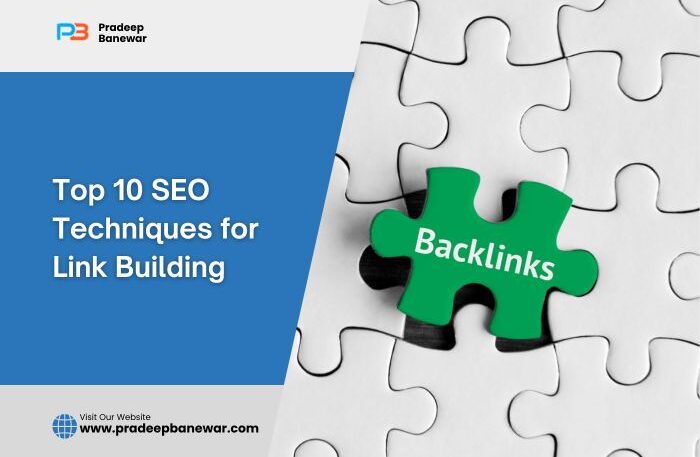Welcome to our in-depth guide to the top 10 link-building techniques for SEO. Effective link-building is essential for increasing your website’s visibility and search engine rankings in the ever-changing world of digital marketing.
We will explore the realm of white hat SEO tactics in this post, emphasizing the value of do-follow backlinks and the principles of link building.
What is a Link Building?
A key component of search engine optimization (SEO) is link building, which is getting links to your website from other websites.
These connections indicate search engines, letting them know how authoritative and relevant your content is. Link building makes your website appear reliable and credible within that industry.
What are Dofollow Backlinks?
Links with a dofollow attribute enable search engines to transfer link juice from one website to another. In simpler terms, when a website uses a do-follow link to point to another website, It effectively endorses the linked site and transfers some of its authority to it. The linked site’s search engine ranking may benefit from this.
It’s crucial to remember that not every link is dofollow by default. Links can also have the “nofollow” attribute added to them. When website owners don’t want to support or attest to the linked content, they frequently use nofollow links, which don’t pass link juice.

Dofollow backlinks are beneficial for search engine optimization (SEO) because they increase the authority of a website and can raise its ranks in search results.
But, since search engines increasingly value relevant, high-quality backlinks more than low-quality ones, it’s critical to concentrate on backlink quality rather than just quantity.
10 Techniques for Link Building
Let’s examine a few significant and potent white-hat SEO link-building strategies.
1. High-Quality Content Creation:
Any effective SEO strategy must start with the creation of high-quality content. It involves creating engaging, educational, and well-researched content to meet the needs of the target audience.
Adding value is crucial in blog posts, articles, videos, and other types of content. In addition to obtaining organic traffic, valuable content promotes other websites to link to it as a reliable source.
2. Guest Blogging:
Writing content for other websites in your niche or industry is known as guest blogging. It’s crucial to pick respectable websites with a target audience when looking for guest blogging opportunities.
Create content that benefits readers and fits the style of the host website. Include a backlink to your website in the content or your author bio. In addition to assisting with backlink building, guest blogging positions you as an authority in your industry.
3. Broken Link Building:
As part of a proactive approach known as “broken link building,” you locate broken links on reputable websites and offer your content as an alternative.
This method requires thorough investigation and a tailored outreach strategy. By offering webmasters your pertinent content to help them fix broken links, they give you a backlink in return for the beneficial service you’re providing.
4. Link Reclamation:
By keeping an eye on brand mentions, you can spot situations where people are talking about your content or brand without providing a link.
Speak with the authors or website owners and kindly request them to link your website. Link reclamation improves your online profile by ensuring you receive credit for your content and brand mentions.
5. Infographics and Visual Content:
Infographics and other visual content are very shareable and link-worthy. Make educational and aesthetically pleasing infographics that make difficult information easy to understand.
Submit these to infographic directories and post them on your website. Include embed codes that direct people to your website so they can easily share and link to your visual content.
6. Social Media Engagement:
Although social signals might not directly affect SEO, having a social media presence can slightly support link development.
Engage with your audience, participate in conversations, and actively share your content on social media. An audience base for your content on social media may result in more natural sharing and linking.
7. Develop Relationships:
One long-term tactic that may result in natural link opportunities is relationships within your industry. Interact with thought leaders, industry influencers, and other professionals via social media, blog comments, and networking events.
Over time, you will get more organic links if you provide value and establish real connections.

8. Resource Link Building:
Developing in-depth guides or resource pages positions your website as an authority in your industry. These resources must be comprehensive, worthwhile, and address primary issues in your field.
Encourage others in your community to use these resources and others will logically associate them with reliable sources.
9. Local SEO and Citations:
These are essential for companies that serve locally. Make sure the details about your company appear consistently on platforms tailored to your industry, on review sites, and in local directories.
In addition to raising your website’s local search engine rankings, these citations offer reputable backlinks from respected local sources.
10. Link to Others:
Don’t be afraid to mention and include links to other excellent and relevant websites in your post. By doing this, you build goodwill with the websites you link to and strengthen the credibility of your content.
Reciprocal linking—where other websites link back to your content—may result from this goodwill.
Your website’s SEO strategy will be more successful in the long run if you use these white-hat SEO techniques for link building.
Remember to concentrate on producing worthwhile content, networking within your sector, and continuously adjusting your strategy in light of changing search engine optimization trends.
Your website’s authority and visibility in the online space will increase if you prioritize using moral and practical link-building strategies.





